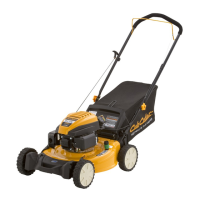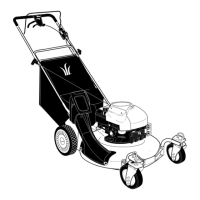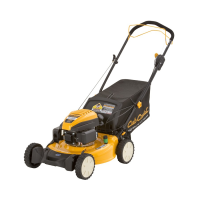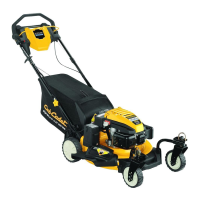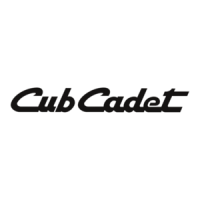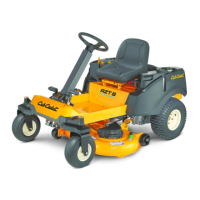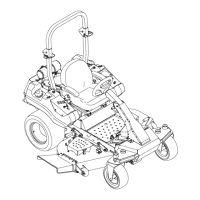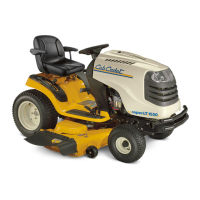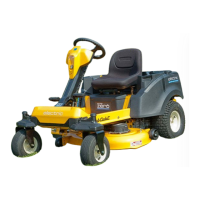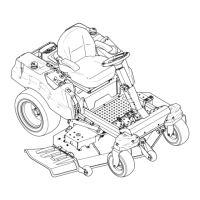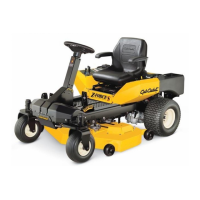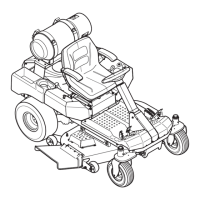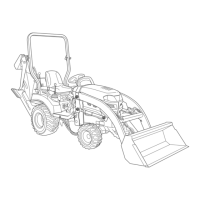
Do you have a question about the Cub Cadet SC2450 and is the answer not in the manual?
| Deck Material | Steel |
|---|---|
| Mulch Capable | Yes |
| Side Discharge | Yes |
| Drive System | Rear Wheel Drive |
| Wheel Size (Front) | 8 inches |
| Wheel Size (Rear) | 11 inches |
Explains the manual's purpose in safety and damage prevention.
Details safety warnings, cautions, symbols, and the meaning of DANGER, WARNING, CAUTION, NOTICE.
Lists critical steps to take before starting tractor operation to ensure safety.
Provides guidelines for starting the tractor and general operational safety practices.
Covers safe practices for operating the tractor, including covers, guards, and communication.
Emphasizes child safety around the tractor and specific precautions.
Details crucial safety procedures and warnings when operating the tractor on slopes.
Outlines safe practices for driving the tractor on public roads, including lights and regulations.
Provides instructions on how to safely park the tractor, including brake engagement and slope parking.
Covers essential safety precautions before, during, and after operating the PTO.
Details safety considerations when using the 3-point hitch and mounted implements.
Explains ROPS importance and precautions for use and maintenance.
Lists crucial safety guidelines for performing maintenance and servicing on the tractor.
Guides users on understanding and maintaining tractor safety decals.
Explains how to find and record tractor, engine, and ROPS serial numbers for service.
Provides detailed technical specifications for the tractor, including engine, capacities, and dimensions.
Lists the tractor's forward and reverse travel speeds based on the range gear lever position.
Details the maximum lifting capacity, hitch load, and towing load for various implements.
Provides a visual overview of the tractor's main external components and their identification numbers.
Identifies and lists all controls found in the tractor's operator station.
Explains the function of individual controls like hazard lights, starter key switch, and preheating.
Describes the function and operation of the throttle control, parking brake lever, and brake pedal.
Explains the forward/reverse drive pedal and the implement control lever, including float position.
Details the function of implement lock, position stop, and cruise control levers.
Explains the 3-point hitch control lever and the 12V DC power outlet.
Describes the function of the HST pressure release lever and the reverse override switch for PTO.
Explains how to select PTO drive and operate lighting and turn signal controls.
Details the operation of the 4-wheel drive lever and hydraulic flow control knob.
Explains the tachometer, fuel gauge, hour meter, and various warning lights on the instrument panel.
Lists essential checks before operating the tractor to ensure safety and proper function.
Emphasizes general safety awareness and operating with "SAFETY FIRST".
Details daily checks for tires, fluids, and general tractor condition.
Provides guidance on cleaning the tractor to prevent damage from chemicals or fuel.
Covers opening the fuel shut-off valve and starting the engine safely.
Explains how to adjust the seat position and reverse it for different operations like backhoe use.
Details how the seat is mechanically raised, rotated, and locked in place.
Instructs on the proper use and importance of the retractable seat belt, especially with ROPS.
Provides a step-by-step guide on how to securely engage the parking brake.
Describes setting the range gear, turning off the PTO, and lowering implements before shutting down.
Explains how to lower implements and adjust the throttle control lever before starting.
Instructs on checking instrument panel lights and preheating the engine using the glow plug.
Details how to start the engine and the importance of warming it up, especially in cold weather.
Provides the correct procedure for safely shutting down the tractor engine.
Guides on how to restart the engine if it stalls, including important precautions.
Explains how to break in a new tractor during the first 50 hours for optimal life and performance.
Details the procedure for lowering and raising the ROPS for safe operation or storage.
Continues the detailed steps for folding and unfolding the ROPS, including securing it.
Covers adjusting the seat, fastening the seatbelt, and using turn signals, headlights, and hazard lights.
Explains how to select the range gear, engage 4-wheel drive, and adjust the throttle for intended speed.
Details how to raise implements using the 3-point hitch control and the function of the implement lock lever.
Covers disengaging the parking brake and slowly depressing the drive pedal to move the tractor.
Explains how to engage and disengage the cruise control feature for maintaining a set speed.
Provides procedures for stopping the tractor normally and in an emergency situation.
Details how to monitor gauges and warning lights during operation for potential issues.
Explains the function of the fuel gauge and the engine coolant warning light.
Explains the function of the hour meter which tracks tractor operating hours.
Covers the steps for applying and releasing the parking brake to safely park the tractor.
Explains how to engage and disengage the differential lock for increased traction and related safety warnings.
Provides crucial safety advice for operating the tractor on public roads, including SMV emblems and lighting.
Reinforces road travel safety, local regulations, and speed limits for tractor operation.
Continues road safety advice, specifically when the tractor is equipped with a backhoe.
Details how to manually move the tractor when the engine is stopped using the HST pressure release lever.
Provides the procedure for using the HST pressure release lever to move the tractor and then re-engaging the brake.
Gives instructions for safely loading, securing, and transporting the tractor on a trailer.
Offers detailed precautions and guidance for operating the tractor safely on slopes and rough terrain.
Explains specific techniques for driving uphill and downhill on slopes, including gear selection.
Discusses the power steering feature and the use/limitations of the 12V DC outlet.
Identifies the locations of the rear and mid PTO shafts on the tractor.
Details the safety interlock system and the procedure for engaging the PTO, including reverse override.
Provides a step-by-step guide for engaging the PTO, including engine speed and lever selection.
Explains how to adjust engine speed for PTO operation and how to disengage the PTO safely.
Covers proper implement installation for PTO drivelines and safety for PTO use in reverse.
Outlines safety precautions for the 3-point hitch and identifies its main components.
Explains how to adjust the right lift link, top link, and sway links for proper implement positioning.
Warns about towing limitations of the hitch and specifies maximum towing load.
Details how to operate the 3-point hitch control lever to raise or lower implements.
Explains the function of the hydraulic flow control knob for adjusting lowering speed and stopping implements.
Covers safety precautions for tire mounting and maintaining correct tire inflation pressure.
Provides specific tire inflation pressures and wheel bolt tightening torque values.
Explains how to add front ballast for stability and lists available front end weights for implements.
Details the use of liquid weight in rear tires for ballast, including safety and correct fill levels.
Presents a comprehensive table of maintenance tasks and their service intervals for the tractor.
Continues the maintenance checklist, covering items like brakes, ROPS, tire pressure, and wiring.
Lists recommended lubricants for various tractor components and information on ordering replacement parts.
Provides instructions on how to safely open and close the tractor's hood.
Continues hood operation instructions and adds a caution about pinching fingers.
Details essential daily checks including visual inspection and refilling the fuel tank.
Lists technical requirements for diesel fuel, including cetane, sulfur content, and bio-diesel considerations.
Explains approved bio-diesel fuel blends and precautions for their use.
Covers safe procedures for refueling the tractor, including warnings about fuel vapor and container use.
Provides instructions on how to check and maintain the engine oil level correctly.
Details the procedure for checking and maintaining the transmission/hydraulic oil level.
Covers inspection of radiator hoses and cleaning of cooling fins and screens.
Continues cleaning procedures for the radiator cooling screen and intake air hose.
Explains how to check the coolant level in the reserve tank and general cooling system safety.
Details inspection of the fuel line and intake air hoses for leaks or damage.
Describes how to check the safety interlock system, focusing on the PTO switch functionality.
Explains how to test the safety switches related to the parking brake, drive pedals, and seat.
Covers checking brake pedal play, seat belt, and ROPS mounting hardware for proper function.
Details checking wheel bolt tightening torque and tire inflation pressure for safety.
Covers inspection of light bulbs, tie-rod rubber boots, and the overall electrical system.
Explains how to adjust the front axle pivot pin to prevent steering wheel vibration.
Details how to check power steering hydraulic hoses for leaks and proper torque.
Covers checking hydraulic hoses for implement control, lift cylinder, and oil cooler for leaks and torque.
Outlines initial maintenance tasks for the first 50 hours, including engine oil and filter changes.
Provides instructions for checking and cleaning the fuel/water separator.
Explains how to check fan belt tension, adjust it, and replace the belt if necessary.
Details lubrication points on the tractor, including drive pedal rod ends and control lever linkages.
Covers lubrication of seat slide rails and the 3-point hitch ball joints and drawbar.
Provides the procedure for changing the engine oil, including safety warnings and recommended oil types.
Details the process for cleaning the fuel/water separator, including safety warnings.
Explains how to service the air cleaner element, including cleaning or replacement.
Continues the procedure for cleaning the air cleaner element using compressed air.
Provides the procedure for replacing the engine oil filter.
Explains how to measure and adjust the front wheel toe-in for proper steering.
Details the procedure for changing the transmission/hydraulic oil and filter.
Continues the procedure for changing transmission/hydraulic oil and replacing the filter.
Provides the procedure for changing the front axle case oil.
Explains how to replace the fuel filter element in the separator and the main fuel filter.
Covers checking and recommended coolants, emphasizing safety when dealing with hot fluids.
Details the procedure for draining and flushing the tractor's cooling system.
Continues the procedure for flushing the cooling system, including safety warnings.
Provides instructions on how to change the engine coolant, including mixture ratios and safety.
Lists annual maintenance tasks like replacing the air cleaner and servicing the cooling system.
Outlines maintenance tasks to be performed every two years, focusing on replacing hoses and lines.
Details safety warnings and precautions to follow when working with the tractor battery.
Explains safe battery handling, electrolyte precautions, and environmental responsibility.
Covers inspecting the battery, and the procedures for removing and installing it.
Details the steps for installing the battery and cleaning the battery terminals and cables.
Provides instructions and safety warnings for jump-starting the tractor using a booster battery.
Explains how to locate and replace accessory fuses in the fuse holder.
Details how to locate and check the alternator and main fuses, noting their slow-blow type.
Provides a step-by-step guide for replacing the tractor's headlight bulbs, including safety warnings.
Details the procedure for replacing the tractor's work light bulbs.
Covers replacing bulbs for the tail lights and turn signal/hazard lights.
Mentions replacing instrument panel bulbs and that headlights are fixed, requiring dealer assistance for adjustment.
Covers safety precautions related to fuel and exhaust fumes when storing the tractor.
Details steps for preparing the fuel system and engine for long-term storage, including stabilizer use.
Outlines the procedures for preparing a stored tractor for its next use, including checks and lubrication.
Provides a table of common engine symptoms, their causes, and remedies.
Covers troubleshooting for excessive machine vibration and issues with the tractor failing to operate.
Addresses common problems with the brake system and steering, including causes and remedies.
Lists optional accessories available for the tractor, such as tires and heaters.
